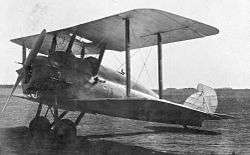Parnall Panther
| Panther | |
|---|---|
 | |
| Role | Carrier-based reconnaissance |
| Manufacturer | Parnall and Sons |
| Designer | Harold Bolas |
| First flight | 1917 |
| Introduction | 1919 |
| Retired | 1926 |
| Primary users | Fleet Air Arm IJN Air Service United States Navy |
| Number built | 155 |
|
| |
The Parnall Panther was a British carrier based spotter and reconnaissance aircraft designed and developed by Parnall and Sons in the latter years of World War I, continuing in service until 1926. A total of 150 Panthers were built by Bristol Aeroplane Company since after the end of World War I Parnall had stopped aircraft manufacture.
Development
The Parnall Panther was designed by Harold Bolas, who had joined Parnall and Sons after leaving the Admiralty's Air Department, where he had served as deputy chief designer under Harris Booth.[1] It was planned to meet the requirements of Admiralty Specification N.2A for a two-seat reconnaissance aircraft capable of operating from aircraft carriers. The first prototype, (serial N91) flew in 1917, with a further five prototypes being produced.[2]
Design
The Panther was a wooden, single-bay biplane, which, unusually for the time,[2] was fitted with a birch plywood monocoque fuselage which could be folded for shipboard storage, the fuselage being hinged aft of the observer's cockpit. The pilot and observer were seated in individual cockpits in the deep fuselage, this giving a good view for landing, but restricting access to the pilot's cockpit. Inflatable floatation airbags were fitted beneath the wings to keep the aircraft afloat in the event of ditching into the sea, with a hydrovane fitted in front of the undercarriage in order to stop the aircraft nosing over.
Operational history
After evaluation, an order for 300 Panthers was placed with Parnall in 1918. However, this was reduced to 150 following the end of the year. Parnall, which had been purchased by W. & T. Avery Ltd. rejected this reduction in the order, so the order was transferred to the Bristol Aeroplane Company,[3] the order being completed between 1919 and 1920.
The Panther served with Spotter Reconnaissance Flights aboard the aircraft carriers HMS Argus and HMS Hermes. While the Panthers handled well in the air, the elderly Bentley engines proved unreliable, and the system of longitudinal arrestor wires in use aboard British aircraft carriers at the time, was unsatisfactory, resulting in many accidents.[2] Panthers continued in service with the Fleet Air Arm until 1926, being replaced by the Fairey IIID.
Twelve Panthers were sold to the Imperial Japanese Navy in 1921-22,[3] with two being sold to the US Navy in 1920.[3][4]
Operators

Specifications
Data from British Naval Aircraft since 1912 [2]
General characteristics
- Crew: two
- Length: 24 ft 11 in (7.60 m)
- Wingspan: 29 ft 6 in (8.99 m)
- Height: 10 ft 6 in (3.20 m)
- Wing area: 336 ft² (31.2 m²)
- Empty weight: 1,328 lb (602 kg)
- Max. takeoff weight: 2,595 lb (1,177 kg)
- Powerplant: 1 × Bentley BR2 rotary engine, 230 hp (172 kW)
- Folded length: 14 ft 6 in (4.42 m)
Performance
- Maximum speed: 94 knots (108.5 mph, 175 km/h) at 6,500 ft (2,000 m)
- Range: 417 nm (480 mi, 773 km [5])
- Service ceiling: 14,500 ft (4,420 m)
- Endurance: 4½ hours
- Climb to 2,000 ft (610 m): 2 min 20 sec
Armament
See also
References
- Notes
- ↑ Mason 1994, pp. 249, 250.
- 1 2 3 Donald 1997, p. 722.
- ↑ Baugher, Joe. "US Navy and US Marine Corps BuNs, First Series - A51 to A5999." US Navy/US Marine Corps Aircraft Bureau Numbers, 14 January 2009. Retrieved: 11 June 2011.
- ↑ Thoenes, Pieter. "WWIFighters.net - Parnell Panther." geocities.com.. Retrieved: 11 June 2011.
- Bibliography
External links
| Wikimedia Commons has media related to Parnall Panther. |